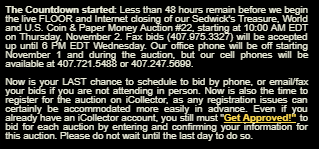Written by the TreasureGuide for the exclusive use of treasurebeachesreport.blogspot.com.
You can view the lots in person on Wednesday and attend the educational talks. If you are not in Orlando, you can view the educational talks that will be streamed live on the Sedwick facebook page.
Here is the schedule of events.
Schedule of Events:
| Wed., Nov. 1 -12:00 PM EDT Lot Viewing starts at the DoubleTree Hotel
| Wed., Nov. 1 -1:30 PM EDT - Jorge Proctor, Numismatist and Researcher: "The Forgotten Mint of Colonial Panama"
| Wed., Nov. 1 -2:45 PM EDT - Manuel Chacón, Curator, The Central Bank of Costa Rica: "Costa Rica Numismatics"
| Wed., Nov. 1 -3:45 PM EDT - Carlos Jara, Numismatist and Researcher: "Central American Provisional And Provincial Mints"
| Wed., Nov. 1 -5:00 PM EDT - Capt. John Brandon, Shipwreck Salvor: “Overview Of Historical Shipwrecks”
| Wed., Nov. 1 -6:30 PM EDT - Dinner sponsored by Daniel Frank Sedwick, LLC
| Thurs., Nov. 2 -10:00 AM EDT - Floor and Internet Auction starts and lot viewing continues throughout the day
| Fri., Nov. 3 -9:30 AM EDT - Floor and Internet Auction starts and lot pick-up available after 1:30 PM.
| Mon., Nov. 6 -11:00 AM EST - Internet only Session Auction starts (Note: Daylight savings ends)
Below is shown lot 213, which has an auction estimate of $80.000 to $120,000.
 |
| Lot 213 in Sedwick Treasure Auction no. 22. Source: Online Sedwick Auction catalog |
Large gold disk, 1434 grams, fineness 0.926, marked "XXXXV" and monogram of V over upside-down V, from the Luz (1752), ex-Sotheby's, ex-Ponterio (cover photo). 3-7/8" in diameter and up to 1/2" thick. A very bright and attractive ingot with boldly inscribed markings, the natural pits and crevices generally filled with encrustation that includes small barnacles and what appear to be hatched eggs. While at first the monogram on this piece appears to be XX for 20K (a logical fineness for such ingots, although testing shows this ingot is .926, over 22K), the lack of serifs in the middle points to that marking being a monogram instead, mostly like an owner's mark, especially since the same marking appears on many other ingots from this wreck. In fact, the other marking on this bar, XXXXV, is almost certainly a serial number 45, in series with other ingots showing the same owner's mark. In his book El Naufragio del Navio Nuestra Senora de la Luz (1968, reprinted in 1992), researcher Juan Alejandro Apolant gives the entire history behind the Portuguese galleon on its Spanish-leased journey all the way through the sinking and subsequent salvage and even auctions of recoveries starting in 1753, and he transcribes the ship's manifest to show that ingots like this one were packed in leather-wrapped cartons marked with the same ciphers on the outside as on the individual ingots, which were referred to as "doblones con la marca de enfrente" (interestingly, the ingots were itemized based on their values in milled 8 escudos rather than actual weights). Because so many of the ingots recovered and offered in our time bear this marking, we surmise that they were part of a large consignment that the manifest shows was made by the governor general of the River Plate Provinces, destined for the King of Spain himself. Curiously, some of the other ingots recovered bear other markings that can be linked to various Jesuit missions, following the 1750 Treaty of Madrid that set a line of demarcation between Spanish and Portuguese colonial territories in South America (which eventually resulted in the Guarani War of 1756, also called the War of the Seven Reductions, which took place between the Guarani tribes of seven Jesuit Reductions [native populations governed by European missions] and joint Spanish-Portuguese forces). The boundary drawn up between the two nations was the Uruguay River, with Portugal possessing the land east of the river (now Brazil). The seven Jesuit missions east of the Uruguay River, known as the Misiones Orientales, were to be dismantled and relocated on the Spanish western side of the river. Therefore it is believed some of the ingots on the Luz were possessions of these relocating missions and were being shipped back to Spain for safeguarding in preparation for the move and conflict. In any case, whether this ingot was the property of the Jesuits or the King, it is undeniably attractive and intrinsically valuable and full of history. From the Luz (1752), pedigreed to the original Sotheby's auction of March 1993 (lot 765) and to the Ponterio auction of April 1997 (lot 2147), in which it was pictured on the back cover of the catalog, with Sedwick photo-certificate.
---
Steve from Sebastian is still not sure about one side of his Cuban coin. He made the following rubbing.
 |
| Rubbing of Obscure Side of Steve's Find. Submitted by Steve |
Below is one of the original photos.
 |
| Photo of Same Coin. Submitted by Steve |
My reader's mostly seem to think it is a centavos, the denomination of which can be determined by the diameter.
I think the questioned side looks very much like a circle in a star, such as the one on the coin shown below.
---
On the Treasure Coast the weather is about as nice as it could be. We only have a one foot surf, but it is a beautiful time to be out on the beach.
Happy hunting,
TreaureGuide@comcast.net



